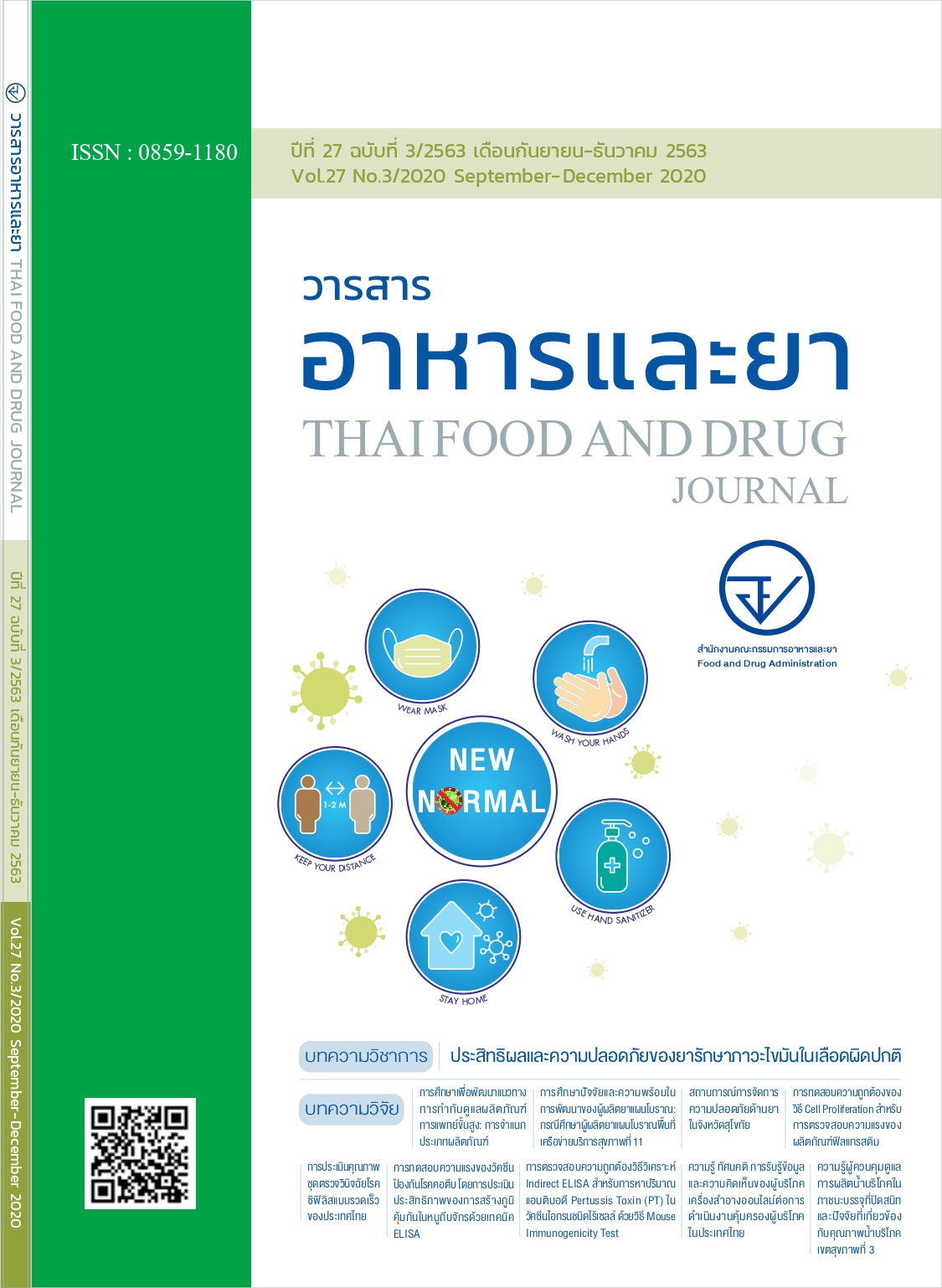การตรวจสอบความถูกต้องวิธีวิเคราะห์ Indirect ELISA สำหรับการหาปริมาณ แอนติบอดี Pertussis Toxin (PT) ในวัคซีนไอกรนชนิดไร้เซลล์ ด้วยวิธี Mouse Immunogenicity Test
Main Article Content
บทคัดย่อ
วัคซีนไอกรนชนิดไร้เซลล์ที่ผลิตในประเทศไทยมี pertussis toxin เป็นองค์ประกอบหลัก ผู้วิจัยจึงได้
พัฒนาวิธีการตรวจความแรงต่อ pertussis toxin ในวัคซีนโดยวิธี Mouse Immunogenicity Test (MIT) ซึ่งเป็น
การตรวจหาปริมาณแอนติบอดีต่อ pertussis toxin (anti-PT) โดยฉีดวัคซีนในหนูถีบจักรและนำเลือดที่ได้มา
ตรวจหาปริมาณ anti-PT ด้วยเทคนิค ELISA ผลการทดสอบพบว่า วิธีนี้มีความจำเพาะ สามารถบอกความแตกต่าง
ของปริมาณ anti-PT ระหว่างกลุ่มทดสอบกับกลุ่มควบคุมได้ โดยกราฟแสดงความสัมพันธ์ระหว่างปริมาณ anti-PT
ต่อค่าการดูดกลืนแสงที่ 450 นาโนเมตรมีความเป็นเส้นตรงในช่วงความเข้มข้นของ anti-PT ระหว่าง 1.95–
4,000.00 mIU/mL ซึ่งค่าสัมประสิทธิ์สหสัมพันธ์ (r) และค่าสัมประสิทธิ์การตัดสินใจ (r2) มากกว่า 0.99 ขีดจำกัด
ในการวัดมีค่าตํ่าสุดเท่ากับ 1.95 mIU/mL และค่าสูงสุดเท่ากับ 4,000.00 mIU/mL ช่วงค่าพิสัยมีค่าระหว่าง
7.81–500.00 mIU/mL การทดสอบความแม่นพบมีค่าความคลาดเคลื่อนสัมพัทธ์อยู่ระหว่าง -2.11–2.37
การทดสอบความเที่ยงมีค่าสัมประสิทธิ์ความแปรปรวนอยู่ระหว่าง 5.57–11.51 การทดสอบความทนของวิธีต่อ
การเปลี่ยนแปลงสภาวะต่างๆ มีค่าสัมประสิทธิ์ความแปรปรวน อยู่ระหว่าง 6.47–9.08 จากผลการตรวจสอบ
ความถูกต้องของวิธี พบว่าข้อมูลข้างต้นอยู่ในเกณฑ์ที่สากลยอมรับ แสดงให้เห็นว่าวิธีที่พัฒนาขึ้นมีความถูกต้อง
แม่นยำเชื่อถือได้ สามารถใช้เป็นวิธีมาตรฐานในการตรวจวิเคราะห์ความแรงโดยตรวจปริมาณ anti-PT ด้วยวิธี MIT
เพื่อใช้ควบคุมคุณภาพด้านความแรงวัคซีนของไอกรนชนิดไร้เซลล์ได้อย่างเหมาะสม
Article Details
เอกสารอ้างอิง
2. Stanley A. Plotkin, Water A. Orenstein and Paul A. Offit. Vaccine 6 TH Edition,Philadelphia, PA: Elsevier, 2013: 449-50
3. WHO Expert Committee on Biological Standardization. WHO Technical Report Series No. 979; 2013: 205-206, 241-4.
4. European Directorate for the Quality of Medicines and HealthCare. European pharmacopoeia 8.0: Assay of pertussis vaccine (acellular). Nördlingen: Druckerei;2014: 252-5.
5. International Conference on Harmonisation of Technical Requirements for Registration of Pharmaceuticals for Human Use. Validation of analytical procedures: text and methodology Q2 (R1). Geneva: ICH Steering Committee;Nov 2005
6. R.G. Das, D. Xing, P. Newland and MJ Corbel. International collaborative Study: Evaluation of Proposed International Reference Reagent of Pertussis Antiserum Mouse) 97/642 Biologicals (2001) 29,137-48.


